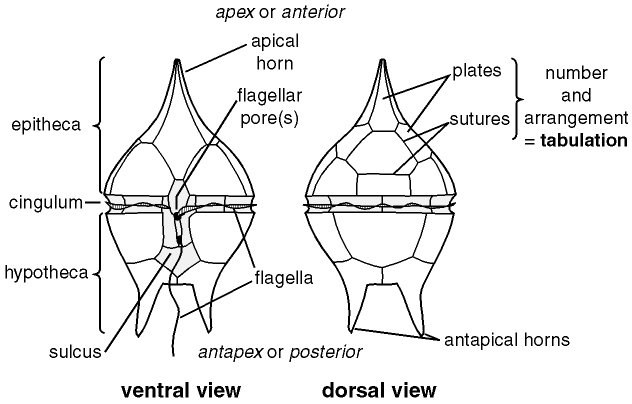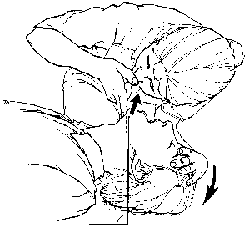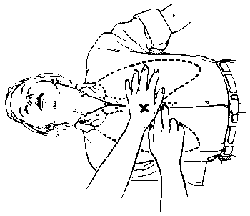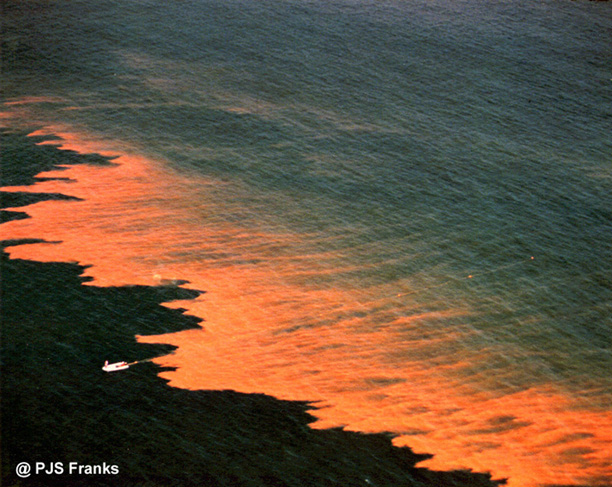
Paralytic Shellfish Poisoning (PSP) is a very dangerous disease that can cause numbness, paralysis, disorientation, and death. PSP comes from contaminated shellfish. These shellfish become contaminated because of a phenomenon called ?red tide.?
PSP is caused by the neurotoxins shellfish get from microscopic plant cells that ?bloom? during the warmer months of the year. This ?blooming? is called red tide.
The first documented occurance of Red Tide was recorded back in the Fall of 1947. The community of Venice, Florida awoke one morning to find thousands of dead fish scattered along the beaches and a strange, choking ?gas? present in the air. There were many different theories as to what had caused this strange and tragic occurance, ranging from nerve gas to a chemical spill. But scientists soon figured out what the real cause was: red tide. Although this was the first actual scientific documentation of a red tide, there are records of many similar events from as far back as the mid 1800's. It?s just that no one knew what the cause was until the case of the dead fish in Venice in 1947.
We now know that Red Tides occur all over the world, affecting everything from Caribbean and South Pacific reef fishes, to Japanese and Scandinavian fisheries, to shell fishing along the U.S. coasts. One of the more recent tragedies that red tide has caused is the deaths of hundreds of dolphins, manatees and whales in North American waters.
Red tides are caused by several species of marine phytoplankton, which are microscopic plant like cells (or algae) that produce potent chemical toxins. These toxins cause contaminate shellfish, kill many different kinds of fish and also can create severe respiratory irritation to any humans who happen to reside nearby.
Dinoflagellates are single celled protists that show a wide diversity of form. The largest, Noctiluca, can sometimes be as large as 2 mm in diameter! Though this isn?t very large by human standards, these organisms can have a huge impact on the environment around them. Many of them are photosynthetic, in other words they manufacture their own food by using energy gotten from the sun, and provide a major food source for other creatures. Some species are able to produce their own light through bioluminescence, which you might know as the thing that makes fireflies glow. Some dinoflagellates are even parasites on fish or other protists.

Some coastal marine species of dinoflagellates can have a dramataic impact on the environment around them because of their tendency to ?bloom? during the warm months of summer. These species reproduce in such vast quantities that the water can actually appear red or golden, in effect producing a "red tide". Many types of marine life suffer when this happens because the dinoflagellates produce a neurotoxin which affects the muscle functions of certain organisms. Even humans can be affected by the toxins when eating fish or shellfish that contain the dinoflagellates? toxins. The diseases which result from this include ciguatera (from eating affected fish) and PSP (from eating affected shellfish, such as mussels, clams, and oysters). These diseases can be serious and occasionally even fatal.
All molluscan shellfish, which includes mussels, geoduck, clams, scallops and oysters can have PSP. Moon snails and other gastropods can also carry the disease. Other marine species, such as sea cucumbers, might also be contaminated. Crabmeat is not known to ever contain PSP, but the guts can be contaminated. In order to be safe, be sure to clean the crab thoroughly and always discard the guts.
Early symptoms can include tingling of the lips and tongue. These symptoms can begin within just a few minutes of consuming the poisonous shellfish, but they can also take up to an hour or even two to develop. How the symptoms progress next depends completely on the amount of toxin the person has ingested.
Tingling in the fingers and toes is usually the next symptom. After that comes the loss of control of arms and legs, which is closely followed by having trouble breathing. Some people have even said they experienced a sense of floating or nausea.
If a person consumes enough of the toxin, the muscles of the abdomen and chest become paralyzed. The person can die in as little as two hours because the muscles used for breathing are paralyzed, hence the name of the disease.
Sadly, there is currently no medication available for PSP. The only form of treatment we have for a severe case is the use of a mechanical respirator and oxygen.
If you suspect that someone near you has eaten contaminated shellfish, the first thing you need to do is see if they are conscious and if they will respond to you. If they are awake, alert, and have no trouble speaking clearly, then have them drink at least 2 glasses of water, each mixed with 3 tablespoons of activated charcoal.
If the person is unconscious, then you must be sure that they have a clear airway and that they are breathing. If they are not breathing, you must breath for them. More information on the specifics of this type of first aid can be found at the First Aid for Paralytic Shellfish Poisoning website.

Next, you must be sure that they have a pulse. If they do not, CPR must be preformed. Again, more information on this kind of first aid can be found at the First Aid for Paralytic Shellfish Poisoning website.

For information on training in your area, inquire at your local ambulance service or fire department or contact:
You can not recognize a contaminated shellfish just by looking at it. Actual testing most be done to determine if a shellfish is contaminated. Also, you can not recognize a red tide area just by looking at it. Some red tide areas have a red or golden discoloration in the water, while some do not. Some look very polluted while some do not. The only way to be sure is to find out which beaches have actually been officially closed due to red tide. To find out which recreational areas and/or beaches are closed call the Marine Biotoxin Hotline at 1-800-562-5632. This information is also available on the Department of Health website at http://www.doh.wa.gov/ehp/sf/biotoxin.htm. Remember not to expect any beaches closed due to PSP contamination or red tide to be marked with a sign.

For more information, call the Washington State Department of Health?s Office of Shellfish Programs at (360) 753-5992 or the Marine Biotoxin Hotline at 1-800-562-5632.